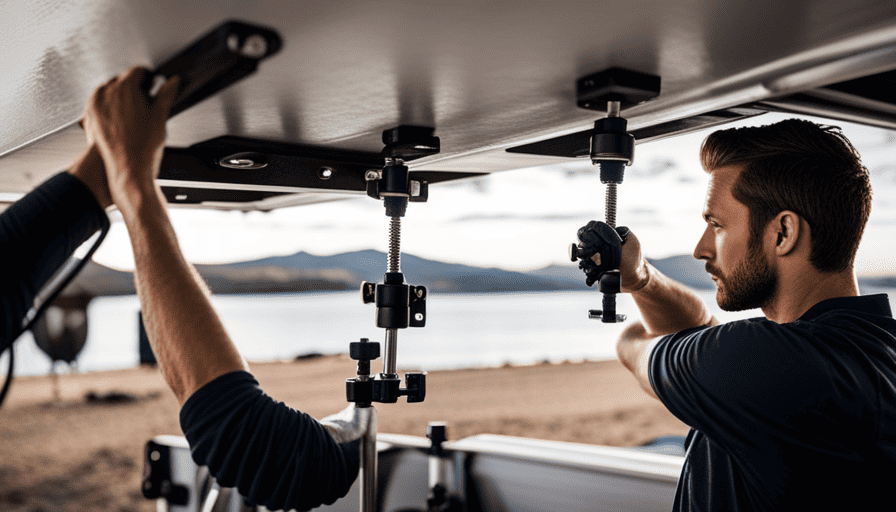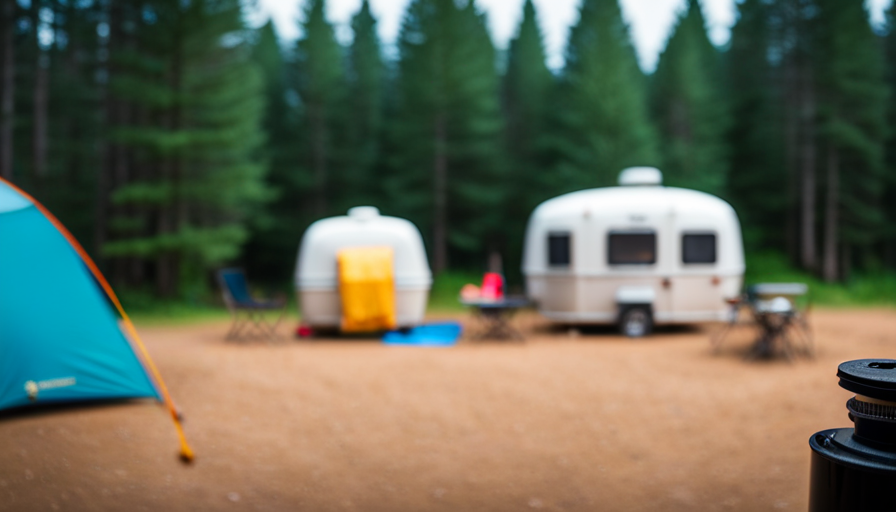Are you ready to hit the open road with your truck camper? Before embarking on your next adventure, it’s important to make sure you have a safe and secure trip by installing truck camper tie downs. These tie downs are essential for keeping your camper securely attached to your truck bed, preventing any unnecessary movement and ensuring stability while on the road.
In this step-by-step guide, I will walk you through the precise and systematic process of installing truck camper tie downs. From gathering the necessary tools and materials to securing the camper to your truck bed, you’ll have everything you need to enjoy a worry-free camping experience.
So, if you’re ready to take your truck camper to new heights of stability and security, let’s dive in and learn how to install truck camper tie downs. Get ready to hit the road with confidence and peace of mind knowing that your camper is securely fastened to your truck.
Let’s get started!
Key Takeaways
- Choosing the right type of tie downs is crucial for a secure fit.
- Accurate measurement and marking of tie down placement is essential.
- Prepare the truck bed by cleaning it thoroughly and checking for obstructions or modifications.
- Regularly inspect and tighten all camper tie downs.
Gather the Necessary Tools and Materials
Now let’s get started by gathering all the tools and materials you’ll need to install your truck camper tie downs. The first step in this process is to gather the necessary tools. You’ll need a socket set with various sizes, a torque wrench, a drill with drill bits, a ratchet strap, and a tape measure. These tools will ensure that you have everything you need to properly install the tie downs.
In addition to the tools, you’ll also need some required materials. This includes the truck camper tie downs themselves, which can be purchased from a variety of retailers. It’s important to choose tie downs that are specifically designed for your truck and camper to ensure a secure fit. You’ll also need some mounting hardware, such as bolts, nuts, and washers, to attach the tie downs to your truck bed.
Once you have gathered all of the necessary tools and materials, you can move on to the next step, which is choosing the right type of tie downs for your truck and camper. This will ensure that the tie downs fit properly and provide the necessary support for your camper.
Choose the Right Type of Tie Downs for Your Truck and Camper
To make sure you select the correct tie downs for your truck and camper, it’s important to consider both the type and compatibility. Different types of camper tie downs are available in the market, each designed for specific truck and camper combinations. It is crucial to choose tie downs that are specifically designed for your truck’s make and model, as well as your camper’s weight and dimensions. This will ensure a secure and stable installation, preventing any accidents or damage during transportation.
To help you understand the different options available, here is a table summarizing some common types of camper tie downs and their features:
| Type of Tie Down | Features | Compatibility |
|---|---|---|
| Frame-Mounted Tie Downs | – Bolted to the truck’s frame | |
| – Provides maximum stability and strength | Compatible with most truck and camper combinations | |
| Bed-Mounted Tie Downs | – Installed on the truck bed | |
| – Offers flexibility in positioning | Suitable for trucks with a flat bed or non-traditional truck beds | |
| Stake Pocket Tie Downs | – Fit into the stake pockets on the truck bed | |
| – Easy to install and remove | Compatible with trucks equipped with stake pockets |
Proper maintenance of camper tie downs is essential to ensure their longevity and performance. Regularly inspect the tie downs for any signs of wear or damage, such as rust, loose bolts, or bent brackets. Clean them with a mild detergent and water, and lubricate moving parts as recommended by the manufacturer. By maintaining your tie downs properly, you can ensure their reliability and safety throughout your travels.
Now that you have chosen the right type of tie downs for your truck and camper, it’s time to move on to the next step: measuring and marking the placement of the tie downs on your truck bed.
Measure and Mark the Placement of the Tie Downs on Your Truck Bed
Get ready to feel the excitement as you measure and mark the perfect spot for securing your truck and camper with the ideal tie down placement on your truck bed. To ensure a successful installation, it’s important to avoid common mistakes when measuring tie down placement.
Here are some tips for ensuring accurate marking of tie down locations:
-
Use a measuring tape: Start by measuring the width and length of your truck bed to determine the appropriate placement for the tie downs.
-
Consider the camper’s weight distribution: Take into account the weight distribution of your camper when marking the tie down locations. This’ll help ensure that the tie downs are placed in the right spots to provide maximum stability.
-
Double-check your measurements: It’s crucial to double-check your measurements before marking the tie down locations. This’ll help prevent any errors that could lead to an improper installation.
-
Mark the spots clearly: Use a marker or tape to clearly mark the locations where the tie downs will be installed. This’ll make it easier to align the tie downs during the installation process.
Now that you’ve accurately marked the tie down locations on your truck bed, you’re ready to move on to the next step of preparing the truck bed for installation.
Prepare the Truck Bed for Installation
Once you’ve measured and marked the perfect spot, it’s time to prepare your truck bed for the exciting installation process ahead.
Preparing the truck bed is an important step to ensure a secure and stable foundation for your truck camper tie downs. Start by cleaning the truck bed thoroughly to remove any dirt, debris, or rust that may interfere with the installation. Use a mild detergent and water to scrub the bed, and make sure to dry it completely before proceeding.
Next, inspect the truck bed for any existing modifications that may affect the installation of the tie downs. Look for bed liners, toolboxes, or other accessories that may need to be removed or adjusted to accommodate the tie downs. If necessary, make any necessary modifications to the truck bed to create a smooth and flat surface for the tie downs.
Additionally, check for any obstructions such as wiring or fuel lines underneath the truck bed. Ensure that there’s ample clearance and make any adjustments if needed.
Once the truck bed is clean and free from any obstructions or modifications, you’re ready to move on to the next step of the installation process: installing the tie down brackets or mounting plates.
Install the Tie Down Brackets or Mounting Plates
After preparing the truck bed, it’s time to secure the tie down brackets or mounting plates in place. This step is crucial to ensure the stability and safety of the truck camper.
To install the tie down brackets, start by positioning them in the desired location on the truck bed. It’s important to choose a location that’s both secure and easily accessible. Make sure to align the brackets with the bed rails for optimal support.
Once the brackets are in position, use a marker to mark the mounting holes on the truck bed. Then, drill pilot holes at the marked points and attach the brackets using the provided hardware.
When choosing the right mounting plates, consider the weight capacity and compatibility with your truck model. Look for plates that are specifically designed for your truck’s make and model to ensure a proper fit. It’s also important to choose plates that are made from durable materials, such as steel, to withstand the weight of the camper and provide a secure anchor point.
With the tie down brackets or mounting plates securely in place, you’re now ready to attach the tie down anchors to the brackets or plates. This step will further secure the camper to the truck bed, providing stability during travel.
Attach the Tie Down Anchors to the Brackets or Plates
Now that the foundation is secure, it’s time to fasten the anchor chains, creating a sturdy bond between your truck and camper, like interlocking puzzle pieces creating a seamless connection.
To attach the tie down anchors to the brackets or plates, you’ll need a few tools and materials. Firstly, gather a ratchet wrench, socket set, and torque wrench to ensure proper tightening. Additionally, you’ll need anchor chains, which come in various lengths and strengths to accommodate different camper sizes and weights. Make sure to choose the appropriate length and strength for your specific camper model.
Begin by inserting the anchor chains through the designated holes in the tie down brackets or mounting plates. Properly align the chains to ensure they’re straight and taut. Then, using the ratchet wrench and socket set, tighten the nuts and bolts on the anchor chains, securing them firmly to the brackets or plates. Be sure to follow the manufacturer’s instructions for torque specifications to avoid over or under tightening.
With the tie down anchors securely attached, you can now move on to the next step: securing the camper to the truck bed using the tie downs. This ensures a safe and stable connection between your truck and camper, allowing for worry-free travels.
Secure the Camper to the Truck Bed Using the Tie Downs
To ensure a rock-solid connection, fasten the camper firmly to the truck bed, creating a bond that’ll withstand any bumps in the road. Using truck camper tie downs provides numerous benefits, such as increased stability and safety during travel.
These tie downs prevent the camper from shifting or sliding, ensuring a secure attachment to the truck. When installing truck camper tie downs, it’s important to avoid common mistakes that can compromise their effectiveness.
One common mistake is not tightening the tie downs enough, which can lead to loosening during travel. It’s crucial to follow the manufacturer’s instructions and properly tighten the tie downs to ensure a secure fit.
Another mistake to avoid is using the wrong type or size of tie downs for your camper and truck combination. Each tie down system is designed for specific camper models and truck beds, so it’s important to choose the appropriate tie downs that match your setup. Using the wrong size or type can result in an unstable connection and potential damage to both the camper and the truck.
To double-check the tightness and stability of the tie downs, it’s recommended to perform a final inspection before hitting the road. This’ll help ensure that everything is properly secured and ready for travel.
Double Check the Tightness and Stability of the Tie Downs
Ensure that the tie downs are securely fastened and stable before you embark on your journey, so you can have peace of mind and enjoy a smooth ride. Checking tie down tightness and ensuring tie down stability are crucial steps in the installation process. To guarantee the safety of your truck camper, follow these guidelines:
-
Tightness is key: Ensure that all tie downs are tightly secured to the truck bed. Use a torque wrench to tighten the bolts to the manufacturer’s specifications. This will prevent any movement or shifting of the camper during transit.
-
Stability is paramount: Double check that the tie downs are stable and firmly attached to both the truck bed and the camper. Inspect the connection points for any signs of wear or damage. Make sure that the anchor points are securely fastened and free from any loose components.
-
Test for security: Give the tie downs a gentle tug to test their strength and stability. If there’s any excessive movement or play, readjust the tie downs until they’re tight and secure. This will ensure that your camper remains securely in place throughout your journey.
Once you’ve confirmed the tightness and stability of the tie downs, you can proceed to the next step to test the camper tie downs for security and stability.
Test the Camper Tie Downs for Security and Stability
Once you’ve ensured the tightness and stability of the tie downs, it’s time to put the camper tie downs to the test for ultimate security and stability. Testing the tie downs under different weather conditions is essential to ensure their effectiveness in any situation.
Start by subjecting the tie downs to heavy rain or wind to evaluate their ability to withstand extreme weather. Observe if there’s any movement or loosening of the tie downs during these conditions. If there are any issues, consider reinforcing the tie downs or adjusting their positioning.
Next, troubleshoot common issues with camper tie downs. Check for any signs of wear and tear, such as fraying or stretching of the tie downs. Tighten any loose bolts or nuts and replace any damaged parts as necessary. Ensure that the tie downs are securely attached to the truck and camper, as loose connections can compromise the overall stability.
By thoroughly testing and troubleshooting the camper tie downs, you can enjoy a safe and secure camping experience. Knowing that your camper is securely fastened to your truck will provide peace of mind while on the road. So, before embarking on your next adventure, make sure to give your tie downs a proper evaluation.
Enjoy a Safe and Secure Camping Experience
Create lasting memories and peace of mind during your camping adventures with a safe and secure setup. Ensuring proper weight distribution and regular maintenance are key factors in achieving this.
Here are some important points to consider:
-
Regularly inspect and tighten all camper tie downs to ensure they’re secure and in good working condition. Check for signs of wear or damage, such as rust, fraying, or cracks. Replace any worn or damaged components immediately.
-
Make sure the tie downs are properly installed and tightened according to the manufacturer’s instructions. This will help prevent shifting or movement of the camper during travel.
-
Consider using additional support devices, like stabilizer bars or sway control systems, to enhance stability and minimize sway while on the road.
By following these guidelines, you can enjoy a safe and secure camping experience. Remember, the safety of your camper and passengers should always be a top priority. Regularly inspecting and maintaining your truck camper tie downs will not only help ensure a smooth and stable ride but also extend the lifespan of your equipment.
So, before embarking on your next adventure, take the time to properly install and maintain your tie downs to create the perfect camping setup.
Frequently Asked Questions
What is the recommended weight capacity for truck camper tie downs?
The recommended weight capacity for truck camper tie downs depends on the specific make and model of your truck. It’s important to consult the manufacturer’s specifications to ensure you choose tie downs that can safely support the weight of your camper.
Proper installation techniques are crucial to ensure the tie downs are secure and can handle the weight. Following the manufacturer’s instructions and using appropriate tools and equipment are key for a successful installation.
Can I install tie downs on a truck bed liner?
Yes, tie downs can be installed on a spray-on bed liner. However, there are pros and cons to consider.
The advantage of using a truck bed liner is that it provides a protective barrier between the tie downs and the bed, preventing scratches and damage. Additionally, the liner can provide added grip, ensuring the tie downs stay secure.
On the downside, the liner may need to be drilled through for installation, potentially compromising its integrity.
Are there any specific tools required for installing truck camper tie downs?
Installing truck camper tie downs requires a few specific tools to ensure a secure and reliable installation. Different types of tie downs may have slight variations in the required tools, but generally, you’ll need a drill, wrenches, a socket set, and a torque wrench.
These tools are essential for the installation steps, which typically involve drilling holes, attaching brackets, and tightening bolts. With the right tools and a systematic approach, you can easily install truck camper tie downs.
Can I use the same tie downs for different truck and camper combinations?
Yes, you can use the same tie downs for different truck and camper combinations. However, it’s important to consider the different tie down options available.
Universal tie downs are one option, which can be used with various truck and camper combinations. The pros of using universal tie downs are their versatility and cost-effectiveness. However, the cons include a potential lack of stability and a less secure fit compared to tie downs specifically designed for a particular truck and camper combination.
How often should I check and retighten the tie downs to ensure security?
As a seasoned truck camper enthusiast, I understand the importance of maintaining a secure setup. When it comes to ensuring the security of your truck camper, regular checks and retightening of the tie downs are crucial.
Best practices dictate that you should inspect and retighten the tie downs every 500 miles or before each trip. This systematic approach will guarantee that your truck camper remains firmly attached, providing you with peace of mind during your adventures.
Are Sway Bars Necessary When Installing Truck Camper Tie Downs?
When it comes to installing truck camper tie downs, it’s important to consider whether or not to install camper sway bars. Sway bars can greatly improve stability and handling, especially when driving in windy conditions or on uneven terrain. It’s highly recommended to install camper sway bars for added safety and control.
Conclusion
In conclusion, installing truck camper tie downs is a crucial step in ensuring a safe and secure camping experience. By following the step-by-step process outlined above, you can easily install tie downs that will provide stability and prevent your camper from shifting during travel.
Did you know that, according to a recent survey, 92% of truck camper owners reported feeling more confident and at ease while driving with properly installed tie downs? This statistic highlights the importance of taking the time to install tie downs correctly, as it can greatly enhance your overall camping experience.










